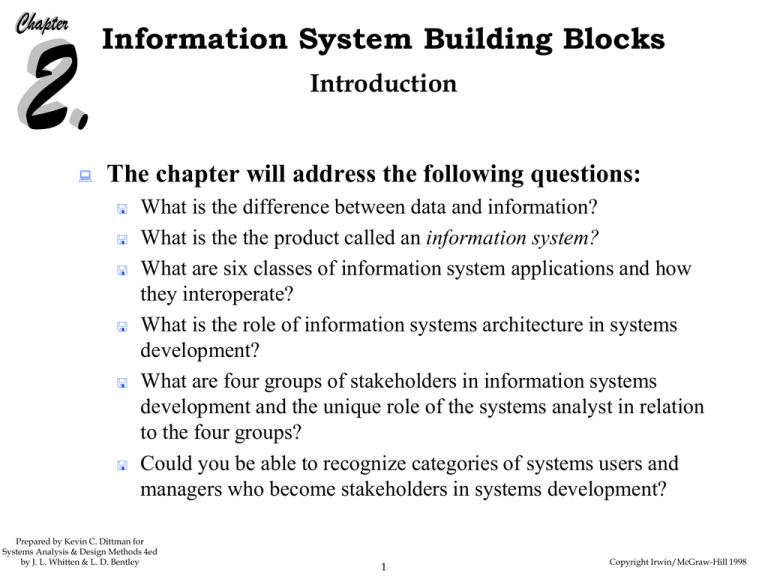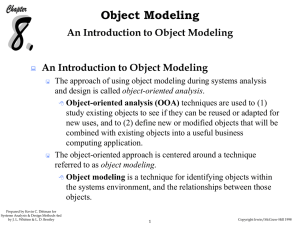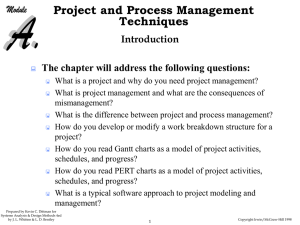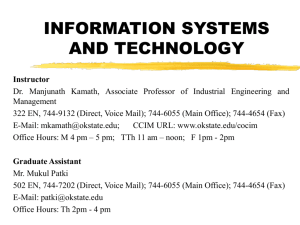Information System Building Blocks
advertisement

Information System Building Blocks
Introduction
The chapter will address the following questions:
What is the difference between data and information?
What is the the product called an information system?
What are six classes of information system applications and how
they interoperate?
What is the role of information systems architecture in systems
development?
What are four groups of stakeholders in information systems
development and the unique role of the systems analyst in relation
to the four groups?
Could you be able to recognize categories of systems users and
managers who become stakeholders in systems development?
Prepared by Kevin C. Dittman for
Systems Analysis & Design Methods 4ed
by J. L. Whitten & L. D. Bentley
1
Copyright Irwin/McGraw-Hill 1998
Information System Building Blocks
Introduction
The chapter will address the following questions:
Can you differentiate between a perspective and a view as it relates
to information systems architecture?
What are four perspectives of the DATA focus for an information
system?
What are four perspectives of the PROCESS focus for an
information system?
What are four perspectives of the INTERFACE focus for an
information system?
What are four perspectives of the GEOGRAPHY focus for an
information system?
Prepared by Kevin C. Dittman for
Systems Analysis & Design Methods 4ed
by J. L. Whitten & L. D. Bentley
2
Copyright Irwin/McGraw-Hill 1998
Information System Building Blocks
A Review of Fundamentals of
Information Systems
What is the difference between Data and Information?
Data are raw facts about the organization and its business
transactions. Most data items have little meaning and use by
themselves.
Information is data that has been refined and organized by
processing and purposeful intelligence.
Information Systems transform data into useful
information.
An information system is an arrangement of people, data,
processes, interfaces, and geography that are integrated for the
purpose of supporting and improving the day-to-day operations in
a business, as well as fulfilling the problem-solving and decisionmaking information needs of business managers.
Prepared by Kevin C. Dittman for
Systems Analysis & Design Methods 4ed
by J. L. Whitten & L. D. Bentley
3
Copyright Irwin/McGraw-Hill 1998
Information System Building Blocks
A Review of Fundamentals of
Information Systems
Transaction Processing Systems
Business transactions are events that serve the mission
of the business.
Prepared by Kevin C. Dittman for
Systems Analysis & Design Methods 4ed
by J. L. Whitten & L. D. Bentley
Transaction processing systems are information system
applications that capture and process data about (or for)
business transactions. They are sometimes called data
processing systems.
5
Copyright Irwin/McGraw-Hill 1998
Information System Building Blocks
A Review of Fundamentals of
Information Systems
Management Information Systems
Management Information Systems supplement
transaction processing systems with management
reports required to plan, monitor, and control business
operations.
Prepared by Kevin C. Dittman for
Systems Analysis & Design Methods 4ed
by J. L. Whitten & L. D. Bentley
A management information system (MIS) is an information
system application that provides for management-oriented
reporting, usually in a predetermined, fixed format.
6
Copyright Irwin/McGraw-Hill 1998
Information System Building Blocks
A Review of Fundamentals of
Information Systems
Decision Support Systems
Decision Support Systems are concerned with
providing useful information to support the decision
process.
A decision support system (DSS) is an information system
application that provides its users with decision-oriented
information whenever a decision making situation arises. When
applied to executive managers, these systems are sometimes
called executive information systems.
A DSS is designed to support unstructured decisions.
Prepared by Kevin C. Dittman for
Systems Analysis & Design Methods 4ed
by J. L. Whitten & L. D. Bentley
7
Copyright Irwin/McGraw-Hill 1998
Information System Building Blocks
A Review of Fundamentals of
Information Systems
Expert Systems
Expert Systems are an extension of the decision support
system.
An expert system is an information system application that
captures the knowledge and expertise of a problem solver or
decision maker, and then simulates the ‘thinking’ of that expert
for those who have less expertise.
Expert systems are implemented with artificial intelligence
technology, often called expert system shells.
Prepared by Kevin C. Dittman for
Systems Analysis & Design Methods 4ed
by J. L. Whitten & L. D. Bentley
10
Copyright Irwin/McGraw-Hill 1998
Information System Building Blocks
A Review of Fundamentals of
Information Systems
Office Information Systems
Office Information Systems are concerned with getting
all relevant information to all those who need it.
Office information systems support the wide range of business
office activities that provide for improved work flow and
communications between workers, regardless of whether or not
those workers are physically located in an office.
Office information systems may use the following
technologies:
Prepared by Kevin C. Dittman for
Systems Analysis & Design Methods 4ed
by J. L. Whitten & L. D. Bentley
•
•
•
•
•
Electronic forms technology
Work group technology
Electronic messaging technology
Office automation suite technology
Imaging technology
11
Copyright Irwin/McGraw-Hill 1998
Information System Building Blocks
A Review of Fundamentals of
Information Systems
Personal and Work Group Information Systems
Personal and Work Group Information Systems
typically are built using personal computer technology
and software.
Personal information systems are those designed to meet the
needs of a single user. They are designed to boost an
individual’s productivity.
Work group information systems are those designed to meet
the needs of a work group. They are designed to boost the
group’s productivity.
Prepared by Kevin C. Dittman for
Systems Analysis & Design Methods 4ed
by J. L. Whitten & L. D. Bentley
12
Copyright Irwin/McGraw-Hill 1998
Information System Building Blocks
Information
need
Any Manager
Transaction
Data
Transaction
information
Transaction
Processing
System
Management
Information
System
Data
Data
Data
snapshots
Business
Database
Data
and
messages
Management
information
Read-only
data
Problem
Decision
Support
System
Decision
support
information
Business Data
Warehouse
Any
User
Communications
between users
and within groups
Office
Information
System
Captured
data
Executive
inquiry
Data
Data
Personal
data
Any
User
Prepared by Kevin C. Dittman for
Systems Analysis & Design Methods 4ed
by J. L. Whitten & L. D. Bentley
Read-only
data
Shared
data
Executive
Information
System
Executive
information
Personal
Information
System
Expert
System
Personal
information
Any
Decision Maker
or
Executive
Personal
data
Problem
Rules
Solution
Personal
Files &
Databases
Any
Relevant
User
Expertise
Database
13
Copyright Irwin/McGraw-Hill 1998
Information System Building Blocks
A Framework For Information Systems
Architecture
What is an Information Systems Architecture?
An information systems architecture provides a unifying
framework into which various people with different perspectives
can organize and view the fundamental building blocks of
information systems.
Stakeholders have different views of the system and each has
something “at stake” in determining the success of the system.
Stakeholders can be broadly classified into four groups:
System Owners
System Users
System Designers
System Builders
Prepared by Kevin C. Dittman for
Systems Analysis & Design Methods 4ed
by J. L. Whitten & L. D. Bentley
14
Copyright Irwin/McGraw-Hill 1998
Information System Building Blocks
INFORMATION SYSTEMS FRAMEWORK
INFORMATION SYSTEM FOCUSES
S
Y
S
T
E
M
A
N
A
L
Y
S
T
S
SYSTEM
OWNERS
INFORMATION SYSTEM SCOPE
(purpose and vision; goals and objectives; costs and benefits)
SYSTEM
USERS
INFORMATION SYSTEM REQUIREMENTS
(WHAT the system "is" and "must do" independent of technology)
SYSTEM
DESIGNERS
INFORMATION SYSTEM DESIGN
(HOW the system will be implemented using technology)
SYSTEM
BUILDERS
INFORMATION SYSTEM COMPONENTS
(the actual, technical implementation of the system)
Data
Technology
Prepared by Kevin C. Dittman for
Systems Analysis & Design Methods 4ed
by J. L. Whitten & L. D. Bentley
Software
Technology
15
Interface
Technology
Networking
Technology
Copyright Irwin/McGraw-Hill 1998
Information System Building Blocks
Perspectives - The People Side of
Information Systems
What are Information Workers?
The term information worker (also called knowledge worker)
was coined to describe those people whose jobs involve the
creation, collection, processing, distribution, and use of
information.
System Owners
System owners are an information system's sponsors and chief
advocates. They are usually responsible for budgeting the money
and time to develop, operate, and maintain the information system.
They are also ultimately responsible for the system’s justification
and acceptance.
Prepared by Kevin C. Dittman for
Systems Analysis & Design Methods 4ed
by J. L. Whitten & L. D. Bentley
16
Copyright Irwin/McGraw-Hill 1998
Information System Building Blocks
Perspectives - The People Side of
Information Systems
System Users
System users are the people who use (and directly benefit from)
the information system on a regular basis – capturing, validating,
entering, responding to, storing, and exchanging data and
information.
There are many classes of system users including:
Internal Users
• Clerical and service workers
• Technical and professional staff
– Knowledge workers are a subset of information workers
whose responsibilities are based on a specialized body of
knowledge.
• Supervisors, middle managers, and executive managers
Prepared by Kevin C. Dittman for
Systems Analysis & Design Methods 4ed
by J. L. Whitten & L. D. Bentley
17
Copyright Irwin/McGraw-Hill 1998
Information System Building Blocks
Perspectives - The People Side of
Information Systems
System Users
There are many classes of system users including: (continued)
Remote and Mobile Users
External Users
Prepared by Kevin C. Dittman for
Systems Analysis & Design Methods 4ed
by J. L. Whitten & L. D. Bentley
18
Copyright Irwin/McGraw-Hill 1998
Information System Building Blocks
Perspectives - The People Side of
Information Systems
System Designers
System designers translate users' business requirements and
constraints into technical solutions. They design the computer files,
databases, inputs, outputs, screens, networks, and programs that
will meet the system users' requirements. They also integrate the
technical solution back into the day-to-day business environment.
Prepared by Kevin C. Dittman for
Systems Analysis & Design Methods 4ed
by J. L. Whitten & L. D. Bentley
19
Copyright Irwin/McGraw-Hill 1998
Information System Building Blocks
Perspectives - The People Side of
Information Systems
System Designers
Today’s system designers tend to focus on technical specialties.
Database designers have a DATA focus.
Software engineers and programmers have a PROCESS (or
program) focus.
Personal computing specialists and systems integrators usually
have an INTERFACE focus.
Network and telecommunications specialists have a
GEOGRAPHY focus.
Prepared by Kevin C. Dittman for
Systems Analysis & Design Methods 4ed
by J. L. Whitten & L. D. Bentley
20
Copyright Irwin/McGraw-Hill 1998
Information System Building Blocks
Perspectives - The People Side of
Information Systems
System Builders
System builders construct the information system components
based upon the design specifications from the system designers. In
many cases, the system designer and builder for a component are
one and the same.
The applications programmer is the classic example of a system
builder.
Prepared by Kevin C. Dittman for
Systems Analysis & Design Methods 4ed
by J. L. Whitten & L. D. Bentley
21
Copyright Irwin/McGraw-Hill 1998
Information System Building Blocks
Perspectives - The People Side of
Information Systems
The Role of the System Analyst
For the system owners and users, the analyst typically constructs
and validates their views.
For the system designers and builders, the analyst (at the very
least) ensures that the technical views are consistent and
compatible with the business views.
Prepared by Kevin C. Dittman for
Systems Analysis & Design Methods 4ed
by J. L. Whitten & L. D. Bentley
22
Copyright Irwin/McGraw-Hill 1998
Information System Building Blocks
Building Blocks - Expanding The
Information System Framework
There are at least four distinct focuses in a system.
DATA - the raw material used to create useful information.
PROCESSES - the activities (including management) that carry
out the mission of the business.
INTERFACES - how the system interacts with people and other
systems
GEOGRAPHY - where the data is captured and stored; where the
processes happen; where the interfaces happen.
Prepared by Kevin C. Dittman for
Systems Analysis & Design Methods 4ed
by J. L. Whitten & L. D. Bentley
23
Copyright Irwin/McGraw-Hill 1998
Information System Building Blocks
INFORMATION SYSTEMS FRAMEWORK
SYSTEM
OWNERS
(scope)
S
Y
S
T
E
M
A
N
A
L
Y
S
T
S
SYSTEM
USERS
(requirements)
SYSTEM
DESIGNERS
(specification)
SYSTEM
BUILDERS
(components)
DATA
FOCUS
PROCESS
FOCUS
INTERFACE
FOCUS
GEOGRAPHY
FOCUS
System
Owners'
views of
DATA
System
Owners'
views of
PROCESSES
System
Owners'
views of
INTERFACES
System
Owners'
views of
GEOGRAPHY
System
Users'
views of
DATA
System
Users'
views of
PROCESSES
System
Users'
views of
INTERFACES
System
Users'
view of
GEOGRAPHY
System
Designers'
views of
DATA
System
Designers'
views of
PROCESSES
System
Designers'
views of
INTERFACES
System
Designers'
views of
GEOGRAPHY
System
Builders'
views of
DATA
System
Builders'
views of
PROCESSES
System
Builders'
views of
INTERFACES
System
Builders'
views of
GEOGRAPHY
Data
Technology
Prepared by Kevin C. Dittman for
Systems Analysis & Design Methods 4ed
by J. L. Whitten & L. D. Bentley
Software
Technology
24
Interface
Technology
Networking
Technology
Copyright Irwin/McGraw-Hill 1998
Information System Building Blocks
INFORMATION SYSTEMS FRAMEWORK
FOCUS ON
SYSTEM
DATA
FOCUS ON
SYSTEM
PROCESSES
FOCUS ON
SYSTEM
INTERFACES
FOCUS ON
SYSTEM
GEOGRAPHY
Marketi ng
SYSTEM
OWNERS
Adverti s ing
Sal es
(scope)
Orders
Canc el lati ons
Servic es
Decomposition Diagram
rejected order
Cust omers
S
Y
S
T
E
M
A
N
A
L
Y
S
T
S
(facilitation)
credit
Check
credit
cust omer
number
SYSTEM
USERS
order
order wit h
valid products
Validate valid order
cust omer
(requirements)
order wit hout
valid
cust omer
approved order
Validate
product s
Products
O rders
approved
order
prices
quantity
in st ock
Release
order
picking
ticket
Data Flow Diagram
Or der
Pr ocessing
Pr ogr am
SYSTEM
DESIGNERS
(specification)
Initiation
Routine
Pr ocess
an Order
Get an
Or der
Validate
an Order
Check
Custom er
Cr edit
Check
Pr oduct
Data
Custom er s
Pr oducts
Shutdown
Routine
File an
Or der
Check
Cr edit
Data
Release
an
Or der
Or der s
Structure Chart
VALIDATE_AN_ORDER.
REPEAT UNTIL NO_MORE_ORDERS
PERFORM CUSTOMER_VALIDATIO
REPEAT UNTIL NO_MORE_ORDER
PERFORM PRODUCT_VALIDATI
END REPEAT.
PERFORM CREDIT_CHECK.
IF CREDIT_CHECK 'BAD' THEN
SYSTEM
BUILDERS
(components)
COBOL Program
Database
Technology
Prepared by Kevin C. Dittman for
Systems Analysis & Design Methods 4ed
by J. L. Whitten & L. D. Bentley
COBOL
Compiler
on
IBM 3090 MVS
25
Interface
Technology
Networking
Telchnology
Copyright Irwin/McGraw-Hill 1998
Information System Building Blocks
Building Blocks - Expanding The
Information System Framework
Building Blocks of Data
Data is the raw material used to produce information.
Goal is to capture and store business data using database
technology.
Prepared by Kevin C. Dittman for
Systems Analysis & Design Methods 4ed
by J. L. Whitten & L. D. Bentley
26
Copyright Irwin/McGraw-Hill 1998
Information System Building Blocks
INFORMATION SYSTEMS FRAMEWORK
FOCUS ON
SYSTEM
DATA
FOCUS ON
SYSTEM
PROCESSES
FOCUS ON
SYSTEM
INTERFACES
FOCUS ON
SYSTEM
GEOGRAPHY
Business Subjects
SYSTEM
OWNERS
(scope)
Custome rs orde r zero,
one , or more products.
Products may be ordered
by zero, one, or more
customers.
Data Requirements
S
Y
S
T
E
M
A
N
A
L
Y
S
T
S
(facilitation)
SYSTEM
USERS
(requirements)
PRODUCT
product-no
product-name
unit-of-measure
unit-price
quantity-av ailable
CUSTOMER
customer-no
customer-name
customer-rating
balance-due
ORDER
order-no
order-date
products-ordered
quantities-ordered
Database Schema
SYSTEM
DESIGNERS
PRODUCT
CUSTOMER
product_no [Alpha(10)] INDEX
customer_no [Alpha (10)] INDEX
product_name [Alpha(32)]
customer_name [Alpha(32)]unit_of_measure [Alpha(2)]
customer_rating [Alpha(1)] unit_price
INDEX
[Real(3,2)]
balance_due [Real(5,2)]
quantity_av ailable [Integer(4)]
(specification)
ORDER_PRODUCT
ORDER
ORDER.order_no
order_no [Alpha(12)] INDEX
PRODUCT.product_no
order_date [Date(mmddyyyy)
CUSTOMER.customer_no quantity_ordered [Integer(2)
Database Programs
SYSTEM
BUILDERS
(components)
CREATE TABLE CUSTOMER
(customer_no CHAR(10) NOT NULL
customer_name CHAR(32) NOT NULL
customer _rating CHAR(1) NOT NULL
balance_due DECIMAL(5,2)
CREATE INDEX cust_no_idx on CUSTOMER
CREATE INDEX cust_rt_idx on CUSTOMER
Database
Technology
Prepared by Kevin C. Dittman for
Systems Analysis & Design Methods 4ed
by J. L. Whitten & L. D. Bentley
Software
Technology
27
Interface
Technology
Networking
Telchnology
Copyright Irwin/McGraw-Hill 1998
Information System Building Blocks
Building Blocks - Expanding The
Information System Framework
Building Blocks of Processes
PROCESSES deliver the functionality of an information system.
Processes perform the work in a system.
The goal is to automate appropriate processes with software
technology.
Prepared by Kevin C. Dittman for
Systems Analysis & Design Methods 4ed
by J. L. Whitten & L. D. Bentley
32
Copyright Irwin/McGraw-Hill 1998
Information System Building Blocks
INFORMATION SYSTEMS FRAMEWORK
FOCUS ON
SYSTEM
DATA
FOCUS ON
SYSTEM
PROCESSES
FOCUS ON
SYSTEM
INTERFACES
Business Subjects
Business Functions
FOCUS ON
SYSTEM
GEOGRAPHY
Marketi ng
SYSTEM
OWNERS
A dverti s ing
S al es
(scope)
Orders
Data Requirements
Canc el lati ons
S ervic es
Business Process
Reqts.
rejected order
Cust omers
S
Y
S
T
E
M
SYSTEM
USERS
credit
cust omer
number
order
(requirements)
Check
credit
order wit h
valid products
Validate valid order
cust omer
order wit hout
valid
cust omer
Validate
product s
(facilitation)
Database Scehma
quantity
in st ock
Release
order
picking
ticket
Application Schema
O rde r
Processing
Program
SYSTEM
DESIGNERS
Initiation
R out ine
Process
an O rde r
G et an
O rde r
Validate
an O rde r
Shut dow n
R out ine
File a n
O rde r
(specification)
Database Structures
C heck
C ust omer
C red it
C heck
Product
D ata
C ust omers
Product s
C heck
C red it
D ata
R elease
an
O rde r
O rde rs
Application Programs
VALIDATE_AN_ORDER.
REPEAT UNTIL NO_MORE_ORDERS
PERFORM CUSTOMER_VALIDATIO
REPEAT UNTIL NO_MORE_ORDER
PERFORM PRODUCT_VALIDATI
END REPEAT.
PERFORM CREDIT_CHECK.
IF CREDIT_CHECK 'BAD' THEN
SYSTEM
BUILDERS
(components)
Database
Technology
Prepared by Kevin C. Dittman for
Systems Analysis & Design Methods 4ed
by J. L. Whitten & L. D. Bentley
O rders
approved
order
prices
Products
A
N
A
L
Y
S
T
S
approved order
Software
(and Hardware)
Technology
33
Interface
Technology
Networking
Telchnology
Copyright Irwin/McGraw-Hill 1998
Information System Building Blocks
Building Blocks - Expanding The
Information System Framework
Building Blocks of Interfaces
There are two critical components to information system
Interfaces.
Information systems must provide effective and efficient
interfaces to the system’s users.
Information systems must interface effectively and efficiently
to other information systems, both within the business, and
increasingly with other businesses’ information systems.
Technologies exist to implement interfaces.
Technologies exist that can almost completely eliminate human
error or intervention.
Technologies exist for system integration.
Prepared by Kevin C. Dittman for
Systems Analysis & Design Methods 4ed
by J. L. Whitten & L. D. Bentley
40
Copyright Irwin/McGraw-Hill 1998
Information System Building Blocks
INFORMATION SYSTEMS FRAMEWORK
FOCUS ON
SYSTEM
DATA
FOCUS ON
SYSTEM
PROCESSES
FOCUS ON
SYSTEM
INTERFACES
FOCUS ON
SYSTEM
GEOGRAPHY
Business Subjects
Business Functions
System Context
A ccounts
R eceivable
D atabase
C redit
SYSTEM
OWNERS
C ustomer
Order
Management
Syst em
Order
Picking
Order
Wa rehouse
(scope)
C redit
Voucher
B ank
Data Requirements
Business Process
Reqts.
Input/Output Reqts.
Firec ra cke r Sa les
S
Y
S
T
E
M
A
N
A
L
Y
S
T
S
SYSTEM
USERS
(requirements)
Database Scehma
Application Schema
Interface Schema
Change
of
Address
New Order
Order Help Complete
(facilitation)
Customer
Form
New Customer
Order Accepted
Logon
SYSTEM
DESIGNERS
(specification)
Order Form
Request Order Help
Help +
First Order
Request
Product
Lookup
Request Product Lookup Help
Product Lookup Help Complete
Database Structures
Application Programs
Component Programs
On Event Help.ButtonClick Do
Change Focus HelpDialog
On Event OKButton Do
Begin
{proecdure}
End
On Event CancelButton Do
SYSTEM
BUILDERS
(components)
Database
Technology
Prepared by Kevin C. Dittman for
Systems Analysis & Design Methods 4ed
by J. L. Whitten & L. D. Bentley
Product
Lookup
Software
(and Hardware)
Technology
41
Interface
Technology
Networking
Telchnology
Copyright Irwin/McGraw-Hill 1998
Information System Building Blocks
Building Blocks - Expanding The
Information System Framework
Building Blocks of Geography
Information systems geography describes:
the distribution of DATA, PROCESSES, and INTERFACES
(the other building blocks) to appropriate business locations
the movement of data and information between those locations
The inclusion of GEOGRAPHY in the framework is driven by the
trend towards distributed computing.
Distributed computing is the decentralization of applications
and databases to multiple computers across a computer
network.
Prepared by Kevin C. Dittman for
Systems Analysis & Design Methods 4ed
by J. L. Whitten & L. D. Bentley
47
Copyright Irwin/McGraw-Hill 1998
Information System Building Blocks
Building Blocks - Expanding The
Information System Framework
Building Blocks of Geography
The most popular application of distributed computing is called
client/server computing.
In a client/server computing application, information system
building blocks are distributed between ‘client’ personal
computers and ‘server’ shared computers. The clients and
servers effectively interoperate to share the overall workload.
Prepared by Kevin C. Dittman for
Systems Analysis & Design Methods 4ed
by J. L. Whitten & L. D. Bentley
48
Copyright Irwin/McGraw-Hill 1998
Information System Building Blocks
Building Blocks - Expanding The
Information System Framework
Building Blocks of Geography
Distributed computing is being driven by several trends.
Organizations that can gain faster access to critical information
have a competitive advantage.
Organizations that can extend their information systems to
include their customers and suppliers have a competitive
advantage.
Organizations operate in more locations, national and
international, then ever before.
Prepared by Kevin C. Dittman for
Systems Analysis & Design Methods 4ed
by J. L. Whitten & L. D. Bentley
49
Copyright Irwin/McGraw-Hill 1998
Information System Building Blocks
INFORMATION SYSTEMS FRAMEWORK
FOCUS ON
SYSTEM
DATA
FOCUS ON
SYSTEM
PROCESSES
FOCUS ON
SYSTEM
INTERFACES
FOCUS ON
SYSTEM
GEOGRAPHY
Business Subjects
Business Functions
System Context
Operating Locations
Data Requirements
Business Process
Reqts.
Input/Output Reqts.
Communication Reqts.
SYSTEM
OWNERS
(scope)
S
Y
S
T
E
M
A
N
A
L
Y
S
T
S
(facilitation)
EDI
Cust
SYSTEM
USERS
order
St.
Louis
HQ
catalog
changes
ship
order
West
Customers
Products
Catalog
East
Customers
credit
credit
(requirements)
LA
Office
ship
order
Indy
Warehouse
NY
Office
ship order
service
Maintenance
Records
Database Scehma
Application Schema
Interface Schema
Network Schema
Communications
Controller
SYSTEM
DESIGNERS
St. Louis
Mainframe
NT Server LA
PBX
NT Server NY
Ethernet LAN/NT
(specification)
Ethernet LAN/NT
Indy AIX Server
Client PC
Database Structures
Application Programs
Component Programs
Client PC
Client PC
Enternet LAN AIX/Lan
Manager
Network Programs
Cre ate AccountType =
Sale sCle rk
Se t OrderDir.Rights=full
Se t CustomerDir.Rights=full
Se t ProductDir.Rights=re ad
Se t OrderAppDir.Rights=copy
SYSTEM
BUILDERS
(components)
Database
Technology
Prepared by Kevin C. Dittman for
Systems Analysis & Design Methods 4ed
by J. L. Whitten & L. D. Bentley
Client PC
Software
(and Hardware)
Technology
50
Interface
Technology
Networking
Telchnology
Copyright Irwin/McGraw-Hill 1998
Information System Building Blocks
INFORMATION SYSTEMS FRAMEWORK
SYSTEM
OWNERS
(scope)
FOCUS ON
SYSTEM
DATA
FOCUS ON
SYSTEM
PROCESSES
FOCUS ON
SYSTEM
INTERFACES
FOCUS ON
SYSTEM
GEOGRAPHY
Business Subjects
Business Functions
System Context
Operating Locations
Customers order zero,
one, or more products.
Products may be ordered
by zero, one, or more
customers.
Accounts
Receivable
Database
Marketing
Credit
Advertising
Customer
Sales
Order
Management
System
Order
Picking
Order
Warehouse
Credit
Voucher
Orders
Cancellations
Services
Chapters 5, 6
Chapters 5, 7
Chapters 5, 7
Bank
Chapters 5, 8
Data Requirements
Business Processes
Interface Requirements
Communication Reqts.
rejec ted order
S
Y
S
T
E
M
A
N
A
L
Y
S
T
S
(facilitation)
SYSTEM
USERS
(requirements)
SYSTEM
DESIGNERS
PRODUCT
product-no
product-name
unit-of-measure
unit-price
quantity-av ailable
CUSTOME R
customer-no
customer-name
customer-rating
balance-due
ED I
C us t
C hec k
c red it
orde r
Valid ate
c us tomer
orde r with
v alid pr oduc ts
v alid or der
orde r without
v alid
c us tomer
appr ov ed o rder
Valid ate
prod uc ts
quantity
in s toc k
Prod uc ts
R ele as e
orde r
Application Schema
Database Structures
SYSTEM
BUILDERS
(components)
any good DB course
Database
Technology
c re d it
S hutdown
Routine
V alidate
an Or der
File an
Or der
NY
O ffic e
Ma in te na nc e
R e c ords
Chapters 5, 8
Interface Schema
Network Schema
C us tome r
Form
N e w C us to me r
P r ocess
an Or der
s hip orde r
Chapters 5, 13, 14
Logon
Get an
Or der
Indy
W a re hous e
s e rv ic e
Or der
P r ocessing
P r ogr am
Initiation
Routine
s hip
orde r
pic k ing
tic k e t
Database Scehma
PRODUCT
CUSTOMER
product_no [Alpha(10)] INDEX
customer_no [Alpha (10)] INDEX product_name [Alpha(32)]
customer_name [Alpha(32)]
unit_of_measure [Alpha(2)]
customer_rating [Alpha(1)] INDEX unit_price [Real(3,2)]
balance_due [Real(5,2)]
quantity_available [Integer(4)]
CREAT E T ABLE CUST OM ER
(custom er_no CHAR(10) NOT NULL
custom er_nam e CHAR(32) NOT NULL
custom er _rati ng CHAR(1) NOT NULL
ba l ance_d ue DECIM AL(5 ,2)
CREAT E INDEX cust_no_i dx on CUST OM ER
CREAT E INDEX cust_rt_i dx on CUST OM ER
Prod uc ts
C a ta log
Ea s t
C us tome rs
c re d it
LA
O ffic e
Chapters 5, 7
ORDER_PRODUCT
ORDER.order_no
PRODUCT.product_no
quantity_ordered [Integer(2)
c a ta log
c ha nge s
Order s
appr ov ed
orde r
pric es
Chapters 5, 6
ORDER
order_no [Alpha(12)] INDEX
order_date [Date(mmddyyyy)
CUSTOMER.customer_no
St.
Louis
HQ
s hip
orde r
Wes t
C us tome rs
O rde r A c c e pt e d
C ha nge
of
A ddre s s
N e w O rde r
Communications
Contr oller
St. Louis
Mainfr ame
NT Server LA
O rde r H e lp C omple te
O rde r Form
Check
Custom er
Cr edit
Check
P r oduct
Data
Check
Cr edit
Data
Firs t O rde r
PBX
R e que s t O rde r H e lp
(specification)
orde r
Firecracker Sales
c us tomer
number
ORDE R
order-no
order-date
products-ordered
quantities-ordered
Chapter 12
Prepared by Kevin C. Dittman for
Systems Analysis & Design Methods 4ed
by J. L. Whitten & L. D. Bentley
c red it
C us tomer s
Release
an
Or der
H e lp +
R e que s t
Prod uc t
Look up
NT Server NY
Ether net LAN/NT
Ether net LAN/NT
R e que s t Produc t Look up H e lp
Indy AIX Ser ver
Custom er s
Or der s
P r oducts
Prod uc t Look up H e lp C omple t e
Prod uc t
Look up
Chapters 11, 16
Chapters 11, 13, 14, 15
Application Programs
Component Programs
VALIDATE_AN_ORDER.
REPEAT UNTIL NO_MORE_ORDERS
PERFORM CUSTOMER_VALIDATIO
REPEAT UNTIL NO_MORE_ORDER
PERFORM PRODUCT_VALIDATI
END REPEAT.
PERFORM CREDIT_CHECK.
IF CREDIT_CHECK 'BAD' THEN
any good
programming course
Software
(and Hardware)
Technology
56
On Event Help.ButtonClick Do
Change Focus HelpDialog
On Event OKButton Do
Begin
{proecdure}
End
On Event CancelButton Do
any good
programming course
Interface
Technology
Client PC
Client PC
Client PC
Client PC
Enter net LAN AIX/Lan
Manager
Chapter 11
Network Programs
C reate Accoun tType =
SalesC lerk
Set OrderDi r.R ights=fu ll
Set C ustomerD ir.Ri ghts=full
Set ProductDir.R ights=read
Set OrderAppD ir.R ights=co py
any good data
communication course
Networking
Telchnology
Copyright Irwin/McGraw-Hill 1998
Information System Building Blocks
Summary
Introduction
A Review of Fundamentals of Information Systems
A Framework For Information Systems Architecture
Perspectives - The People Side of Information
Systems
Building Blocks - Expanding The Information
System Framework
Prepared by Kevin C. Dittman for
Systems Analysis & Design Methods 4ed
by J. L. Whitten & L. D. Bentley
57
Copyright Irwin/McGraw-Hill 1998






